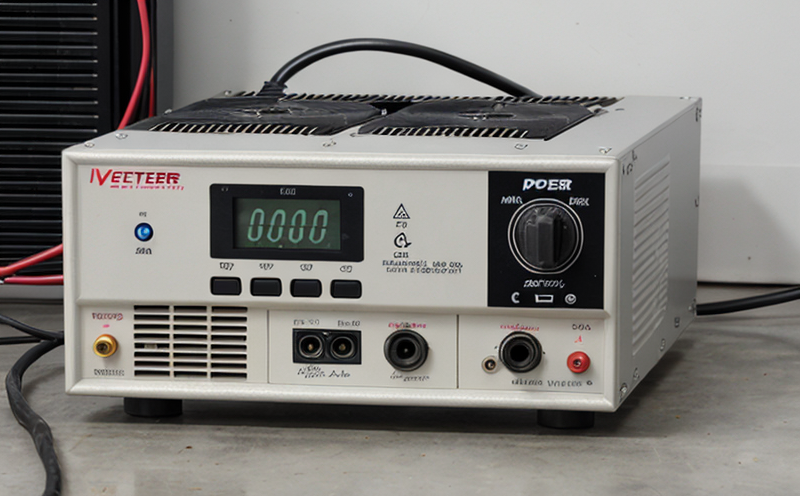CENELEC EN 50549 Grid Connection Testing of Inverters
The CENELEC EN 50549 standard is a crucial regulatory requirement for the grid connection of inverters in renewable energy systems. This standard ensures that power electronics, specifically inverters, comply with technical and safety requirements to prevent disturbances on the electrical distribution network.
Inverters are pivotal components in photovoltaic (PV) systems, wind turbines, and other renewable energy sources. They convert direct current (DC) from solar panels or wind turbines into alternating current (AC), which can be used by households and fed back into the grid. Given that inverters operate at high power levels and interact directly with the electricity grid, their design must adhere to stringent standards like CENELEC EN 50549.
The testing under this standard involves a series of comprehensive checks aimed at verifying that an inverter can safely connect to and operate within the electrical network. This includes ensuring compatibility, stability, and safety while connected. The tests are designed to evaluate various aspects such as short circuit current limiting, fault ride-through capabilities, harmonic distortion, and power factor correction.
The process begins with a detailed review of the inverter’s design documentation to ensure it meets all specified requirements. This is followed by the actual testing phase, which includes:
- Short-circuit current limit verification
- Fault ride-through capability assessment
- Harmonic distortion measurement
- Power factor correction evaluation
- Islanding protection evaluation
- Voltage and frequency stability checks
The testing environment must replicate real-world grid conditions, which can vary significantly depending on the specific requirements of the network operator. This often involves using sophisticated simulation tools to mimic different scenarios that an inverter might encounter during operation.
Once the tests are completed, a comprehensive report is generated detailing all test results and compliance status against the CENELEC EN 50549 standard. Compliance with these standards not only ensures safety but also enhances the reliability of renewable energy systems, contributing to sustainable power generation practices.
Applied Standards
The primary regulatory framework for grid connection testing is CENELEC EN 50549. This standard is internationally recognized and widely adopted in Europe and beyond. Other relevant standards that may be referenced include IEC 61851, which deals with the protection of electricity supply systems against short-circuits, and IEEE 1547, which specifies interconnection requirements for distributed resources.
These standards are designed to ensure compatibility between different components within a grid-connected renewable energy system. They provide guidelines on how inverters should be constructed and tested to minimize the risk of disturbances during operation. The compliance with these standards is crucial for achieving seamless integration into existing power networks, thereby supporting broader sustainable development goals.
The application of these standards ensures that all stakeholders—manufacturers, installers, and operators—are working towards consistent quality and safety benchmarks. This harmonization across different regions helps foster a more efficient and reliable renewable energy sector globally.
Benefits
- Safety Assurance: Ensures that the inverter complies with all necessary safety regulations, protecting both the equipment and personnel involved.
- Regulatory Compliance: Helps manufacturers meet stringent regulatory requirements, thereby avoiding potential legal issues and penalties.
- Better System Performance: Through rigorous testing, inverters are optimized for efficient performance under various grid conditions, enhancing overall system reliability.
- Promotes Renewable Energy: By ensuring compatibility with the electrical grid, this testing facilitates a smoother integration of renewable energy sources into existing infrastructure.
- Economic Efficiency: Early identification and rectification of issues during the testing phase can save costs associated with post-installation troubleshooting and repairs.
- Environmental Impact Reduction: Ensures that inverters operate efficiently, thereby minimizing unnecessary power loss and contributing to energy conservation efforts.
The successful completion of CENELEC EN 50549 grid connection testing not only guarantees compliance with international standards but also positions the inverter as a reliable and high-quality product. This certification is essential for market access and can significantly enhance brand reputation among consumers and industry partners.
Environmental and Sustainability Contributions
The testing under CENELEC EN 50549 plays a pivotal role in promoting sustainability by ensuring that inverters operate efficiently and safely within the electrical grid. By minimizing the risk of disturbances, these tests contribute to reducing power losses and enhancing overall system reliability.
- Power Efficiency: Ensuring that inverters are optimized for maximum efficiency helps reduce energy consumption and associated carbon emissions.
- Harmonic Control: The standard’s focus on harmonic distortion minimizes noise pollution in the grid, which is crucial for maintaining a clean and stable power supply.
- Fault Ride-Through Capability: This feature ensures that inverters can withstand short-term faults without causing further damage to the system or nearby equipment.
- I-PV Islanding Protection: Prevents isolated PV systems from feeding electricity into the grid during a power outage, which could be dangerous for maintenance personnel and other users.
The successful implementation of these standards not only supports broader sustainability goals but also fosters innovation within the renewable energy sector. Manufacturers are encouraged to develop more advanced technologies that meet increasingly stringent environmental and safety criteria.
By adhering to such rigorous testing protocols, manufacturers can contribute significantly to the global push towards cleaner energy solutions. This aligns with international commitments to combat climate change and promotes a shift towards sustainable development practices worldwide.





